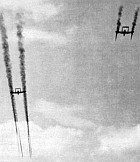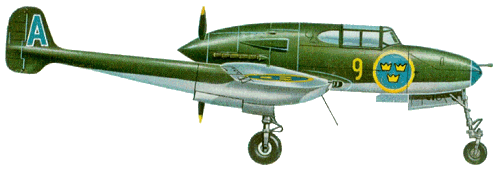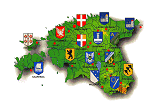In 1941 Svenska Aeroplan AB started the initial project work on a new fighter aircraft. Previous designs from the Swedish company had been largely conventional, but the J 21 project now developed broke new ground from the outset. The most striking features included the installation of the power-plant behind the cockpit, in the rear of the fuselage nacelle, driving a "pusher" airscrew; in keeping with this, the general layout of the aircraft featured a twin-tail-boom unit reminiscent of the Lockheed P-38 Lightning, and a nose-wheel undercarriage. Both these basic features were quite new in SAAB design history. The advantages of this layout were obvious; the armament could be
 |
| A production J.21A of Flygflottilj 9 at altitude. Based at Goteborg, this Wing received its first J.21A-1's in 1946 |
concentrated in the nose giving greater fire-power and easing service and maintenance requirements, and the pilot's visibility was immeasurably better than in conventional aircraft. On the other hand, the construction of this radical aircraft gave rise to many problems which the SAAB engineering staff had to solve one by one as they became apparent.One of the main difficulties was pilot safety in the event of it becoming necessary to abandon the aircraft. A normal emergency exit would cause the pilot to be thrown into the airscrew arc, with inevitably fatal results. Many alternative solutions were examined; some of them displayed an ingenuity which was perhaps out of
 |
| The initial prototype of the J.21A series, serial number 21001, first flown 30th July 1943. Note the original form of the tailplane. |
keeping with the aircraft's projected role as a first-line fighter machine. One suggestion was that the propeller could be blown off by the pilot triggering a charge before baling out; another was that the entire engine be blown out of the aircraft by a dynamite charge. A third solution considered was the installation of a device reminiscent of the Junkers "bomb crutch", to throw the pilot well clear of the airscrew. Finally a type of ejector seat was designed and fitted, one of the first examples of this type of equipment ever to be installed in a service aircraft. Practical tests were carried out on the ground and |
| The J.21A production line at SAAB's Trollhattan plant |
in the air, using a SAAB 17.In order to test the nose-wheel undercarriage, a steel platform was constructed to which all three undercarriage members were attached. The structure was towed behind a truck during the test programme. For pilot familiarisation purposes an Sk 14 (N.A. 16-4M) was equipped with a non-retractable nose-wheel undercarriage.
The estimated speed of 640km/h necessitated an engine more powerful than the STW C-3 (Pratt & Whitney R-1830) originally selected to power the SAAB 21. Svenska Flygmotor AB (SFA) at Trollhattan were instructed to provide an alternative selection. However, due to the very short time available, a licence-built version of an
 |
| Note the rocket racks under the wing of this J.21A of the 2nd Squadron of F6 |
existing foreign powerplant proved to be the only satisfactory alternative. This was the German Daimler Benz DB 605B liquid-cooled 12-cylinder inline engine, rated at 1,475hp for take-off. At that time the engine was not fully developed for other than limited use; and SFA were forced to carry out a considerable amount of re-design and modification work. The engine was eventually built in fairly large numbers by Flygmotor and was used in the SAAB 18B as well as the SAAB 21A. The unconventional pusher fighter featured a low wing arrangement with twin-boom tail and a low drag airfoil of original design. The main landing gear retracted into |
| A view of the prototype J.21A after painting in Swedish Air Force colours. Note nacelle details and long nose-wheel undercarriage |
the tail booms behind the rear wing spar, thus eliminating the usual difficulties caused by cut-outs in the lower wing panels for wheel-wells. However, a number of other systems had to be accommodated in the wing, rendering the design and stress analysis a complicated procedure. In order to provide sufficient fuel space within the fuselage, the tank had to be lowered into a well in the wing centre section. The aerodynamicists strongly emphasised the important reductions in minimum drag and engine cooling drag effected by placing the oil and liquid coolers and the complete duct system for the DB 605B engine inside the airfoil contour between the fuselage |
| A view of the prototype J.21A after painting in Swedish Air Force colours. Note nacelle details and long nose-wheel undercarriage |
and the tail booms.Three test aircraft were constructed, carrying the serials 21 001, 21 002 and 21 003. (The third was only completed as a fuselage, to test stress factors.) The first flight took place on 30th July 1943, and proved to be eventful; due to the selection of too great a flap angle the take-off run was considerably longer than anticipated. One of the undercarriage members was smashed against a fence at the end of the runway; nevertheless, test pilot Claes Smith managed to lift the machine into the air and later carried out a successful landing on his remaining two wheels.
The Flygvapnet (Swedish Air Force) ordered
 |
| White "B" of F9's staff flight |
an initial batch of 54 aircraft, and these were designated J 21A-1. Production took place at the SAAB plant at Trollhattan; and deliveries were completed during 1945 and 1946. Progressive re-ordering led to a total of 298 SAAB J 21A models being constructed before production ceased in 1948.SAAB 21A VARIANTS
J 21A-1
The first production version of the fighter; 54 aircraft delivered between 1st December 1945 and 5th December 1946. The armament consisted of four 13.2mm heavy machine guns and one 20mm cannon grouped in the nose. All were of Hispano manufacture.
J 21A-2
Two production series, each of 62 aircraft delivered between 13th July 1946 and 14th November 1947. The
 |
| Dramatic view of two A.21A's discharging rocket armament during manoeuvres |
aircraft did not differ from the initial production model other than in armament (Swedish Bofors M.45 guns) and being fitted with further direction horizon instrumentation. B 21A-3
The final production batch consisted of 119 aircraft delivered to the Flygvapnet during the period 22nd May 1947 - 17th January 1949. These aircraft differed from their predecessors in being equipped with external bomb and rocket racks and underwing attachment points for external fuel tanks. The B21A-3 could carry one 600kg, 500kg or 250kg bomb, four 50kg bombs, and eight light or two heavy rockets. The main gun armament did not differ from the previous sub-type.
Alternative designations for the series included J
 |
| Line-up of J.21A's with F9 at Goteborg; these are 3rd Squadron aircraft |
2IA-3 and A 21A-3 (for attack).AIR FORCE DELIVERIES
The first fighter unit to receive the type was F 8 Wing at Barkarby. A few examples were delivered in December 1945, and served as staff and familiarisation machines.
F 9 Wing at Goteborg started to convert from the J 22 (FF.VS 22) to the J 21A-1 in 1946. The type served with this unit until replaced by the J 28B (DH Vampire FB Mk. 50) in 1950. F 15 at Soderhamn received their J 21ís the same year as F 9, but did not re-equip with Vampires until 1953.
Based at Kalmar, F 12 converted from the SAAB 17 attack aircraft in
 |
| This fine study of an A.21A in service with F7 at Satenas shows to advantage belly detail and the heavy bomb rack under the centre-section |
1947, receiving the J 21A-2. The unit re-equipped with the SAAB J 29 in 1952 and 1953.The F 6 and F 7 Wings at Karlsborg and Satenas respectively received the J 21A-3; the former unit's aircraft were replaced by SAAB 29Bs in 1953. F 7 was equipped with the J 21R (jet conversion of the 21A - see below) in 1951.
FURTHER DEVELOPMENT
The unorthodoxy of the design of the J 21 caused some doubts as to the aircraft's usefulness; and as an alternative to the type, the Swedish Air Board gave SAAB instructions to proceed with project studies on the SAAB 23. Like the "21", this fighter was built
 |
| Note intake detail displayed by blue "A" of Flygflottilj 7. |
around the Daimler Benz DB 605B engine; but there all resemblance ended. In general appearance the "23" was very similar to the North American F-51 Mustang; but its characteristics were considerably inferior to those of the pusher fighter and the "Swedish Mustang" project was abandoned in favour of the J 21.Various studies aimed at improving the performance of the J 21 were carried out in 1945. During the spring of that year it was planned to produce a J 21B variant, powered by a Rolls-Royce Griffon engine of 2,000hp, giving the aircraft a top speed of 670km/h. The SAAB 27 development was also planned around the Griffon, driving
 |
| The first jet fighter designed, built and operated in Sweden; note the white-painted rear fuselage of the J.21R prototype during initial flights. The maiden flight was made by Ake Sunden on 10th March 1947. |
a contra-prop and with an estimated top speed of 700km/h. However, as 1945 drew to a close all further projects concerning re-engining the J 21 with piston powerplants, and all new piston-engined designs, were abandoned.SAAB had begun jet project studies in the spring of 1945, and these were designated RX 1 and RX 2. The companies working on jet engine design at that time were Svenska Ffygmotor AB (SFA), AB Lundstroms Angturbin (ALA) and Svenska Turbinfabriken AB Ljungstrom (STAL). The RX 1 project featured a twin-tail-boom layout similar to SAAB 21 and the DH Vampire, and was to be powered by an engine of some 1500kg thrust. The
 |
| J.21R production at Linkoping. First estimates indicated that only 20% redesign work would he necessary to convert the J.21A airframe for jet power, but in fact the alterations were nearer 50% |
estimated maximum speed was 740km/h. The RX 2, or "Merry Widow", was inspired by the American Northrop P-61 "Black Widow", also a twin-boom design. The first project to be worked out in detail for a jet-propelled aircraft was the R 101; work had started in the autumn of 1945. It was very similar to the F-80 Shooting Star, of which SAAB had no knowledge at the time. The R 101 project was abandoned when the first illustrations and descriptions of the F-80 were released for publication.SWEDEN'S FIRST JET
SAAB were anxious to obtain experience in the design and construction of a jet fighter; and in the autumn of 1945
 |
| One of the J.21R prototypes, with ring-tip fuel tanks. |
it was thus decided that a jet-propelled version of the J 21A should be produced. For use as prototypes, four production J 21A-Ts were taken out of the assembly line and converted; these were aircraft numbers 21 116, 21 119, 21 121 and 21 123. The engine available at the time was the de Havilland Goblin, and some examples were purchased and installed in the J 21R prototypes. The first flight took place on 10th March 1947 at the base of fighter wing F 13; the test pilot was Ake Sunden.When the detailed plans for the conversion were studied, it was calculated that the necessary airframe alterations would
 |
| An F10 machine shows to good effect the new tail layout of the jet-propelled variant. This machine awaits delivery at the SAAB plant. |
be of the order of 20%; in fact, when the J 21R was finally ready for construction, it differed from the original J 21A by more than 50%. Widespread changes in fundamental construction had been found necessary for the installation of the Goblin powerplant in the fuselage; the air intake was placed on each side of the fuselage and the tail plane had to be raised to the top of the fins. All available space inside the fuselage was devoted to fuel storage. The SAAB 21R was by no means an unqualified success, but its design and construction provided unique experience which was of inestimable value to SAAB |
| Colourfully decorated weapons pack installed on a J.21RB; this pod mounted eight heavy machine guns, bringing total gun armament to twelve machine guns and one 20mm cannon |
in later projects.SAAB 21R VARIANTS
The initial order called for 120 aircraft, but this was later reduced to 64. The armament consisted of the standard battery of four 12.7mm machine guns and one 20mm cannon, but this could be augmented by the mounting of a pack under the fuselage, containing no less than eight machine guns. Rockets could be carried under the wings.
J 21RA
This was built in 34 examples, including the four prototypes, delivered during the period 2nd August 1949 to 21st August 1950. The engine was the original DH Goblin 2, which carried the Swedish designation RM 1.
J 21RB
A total of 30 J 21RB's were delivered
 |
| Fine study of two J.21R's seconds after take-off. Flygflottilj 10 operated the type between 1950 and 1953, later re-equipping with the J.29. The unit provided part of the day fighter strength of the Flygvapnet's No.2 Group |
to the Flygvapnet between 1st July 1950 and 24th January 1951. The engine was a Swedish-built Goblin 3 designated SFA RM 1A, delivering 1500kg thrust. All J 21R production was undertaken at Linkoping.
AIR FORCE DELIVERIES
The J 21R served as an attack aircraft with F 7 Wing, replacing the J-21A-3 in 1951. In 1954 it was itself replaced by the A 29B. F 10 also operated the J-2IR (or A 21R as it was sometimes designated) from 1950 to 1953; re-equipment with the J 29A then took place. At Kallinge, F 17 operated both the J 21 R and the T 18B (SAAB 18TB)
 |
| This F10 aircraft appears to have suffered surprisingly light damage after an undercarriage failure |
in parallel until re-equipped with the A 32A (SAAB 32A) in 1956.Each Wing was organised into three flying squadrons, distinguished by coloured code letters; first squadron red, second squadron blue, third squadron yellow. F11 mustered an extra squadron, designated the 5th, which used green and later black codes. Staff aircraft were indicated by the use of white.
Surviving SAAB 21's in Sweden
J 21A-3, serial 21286, marked as Blue A of F 8, at the Stockholm Museum of Technology.
J 21A-3, serial 21311, marked as Red A of F 9, at the Wing's base at Goteborg.
J 21A-3, serial 21364, marked as an aircraft of F 12, in the Swedish Air Force Museum on F 3 Wing's base at Malmslatt.
(C) Bo Wildfeldt, 1966





















